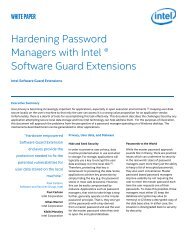BATTLEFIELD DIGITAL FORENSICS
BDF_Battlefield_Digital_Forensics_final
BDF_Battlefield_Digital_Forensics_final
Create successful ePaper yourself
Turn your PDF publications into a flip-book with our unique Google optimized e-Paper software.
A communication channel to satellite can be set up over portable Wi-Fi internet hotspots, which establish<br />
WLAN in the target area and create a connection to satellite from this network. 52 These devices can provide<br />
350-500 kbit/s internet access over satellite links, and can be deployed in less than a minute; they weigh nearly<br />
11 kg meaning they can be carried by SOF operators. If the target digital device has a wireless network<br />
interface, it can be configured to access the internet over these hotspot points by the surveillance software<br />
installed during the operation. The hotspot can create a wireless area within a range of 100 meters. Its internal<br />
battery can run for up to 5 hours, which means that in case of having no external power supply, the<br />
communication channel is still able to obtain approximately 1 GB of data even if the MAC efficiency is not taken<br />
into consideration. The location of the hotspot should be carefully chosen, as it requires to be on the surface<br />
with a clear view of the sky and within 100 metres of the target digital device. If both conditions cannot be<br />
satisfied due to a long distance from the digital device, repeater devices can be used between the hotspot and<br />
the location. Foldable solar panels can be used for recharging the battery, which may help to collect much<br />
more data after the end of the mission.<br />
A cheaper alternative to providing internet access can be the use of satellite phones as internet hotspots. 53<br />
However, the low data transmission rates, such as 2.5 Kbps, make this alternative impractical for battlefield<br />
digital forensics purposes.<br />
9.5 Access to UAVs and Other Aerial Vehicles<br />
An aerial vehicle located near the target site may act as a gateway to a satellite or it can itself host the data<br />
collector server. Depending on the offensive capabilities of the enemy, this vehicle may continue to operate or<br />
may move away from the site after the completion of the mission. In most cases, its level of security may be<br />
correlated with its operating altitude, with higher altitudes meaning better security. On the other hand, as the<br />
targeted area encompasses a relatively small extension such as several square kilometres, the functional<br />
requirements do not require operating at higher altitudes. Additionally, lower altitudes may enable data<br />
transfers with higher rates, thus obtaining more forensics data. Based on the altitude, the vehicles are<br />
categorised into two groups: high altitude platforms and low altitude platforms.<br />
High altitude platforms: aeroplanes, balloons or airships, operate between 20 and 50 km. The Northrop<br />
Grumman RQ-4 Global Hawk UAV is an important and widely known example of a high altitude platform.<br />
Google’s Project Loon has air balloons travelling approximately 20 km above the Earth’s surface in the<br />
stratosphere. Project Loon uses software to determine where its balloons need to go, and to move the balloons<br />
into the correct layer in the stratosphere to be moved with the wind to the desired locations. Electronics in the<br />
balloons are powered by solar panels. Each balloon can provide connectivity to a ground area about 80 km in<br />
diameter using LTE. The balloons relay traffic from LTE-enabled devices such as cell phones back to the global<br />
internet. The project’s pilot test phase started in June 2013 [41].<br />
It is uncertain if in the future it will be possible to rent the Project Loon communication networks from Google,<br />
for example to provide LTE connectivity for specific areas. If not, there is also balloon-based communication<br />
provided for the military. Space Data provides SkySat, which is a balloon-based repeater platform. Balloons are<br />
also working in the stratosphere; 54 it is claimed they extend the range of standard-issued military two-way<br />
52 http://www.groundcontrol.com/MCD-4800_BGAN_Terminal.htm<br />
53 http://www.groundcontrol.com/Satellite_Phones.htm<br />
54 There are also examples of using air balloons a lot closer to Earth: based on [42], in 2013 Oceus Networks [43] applied for permission to<br />
demonstrate a LTE-based tactical communication system for the US Army, in which air balloons were tethered only 650 meters from the<br />
ground. The shorter the distance between balloons and LTE-enabled devices, the more bandwidth can be used. However, if the air balloons<br />
can be easily seen by the enemy, various risks arise, such as shooting them down.<br />
56





